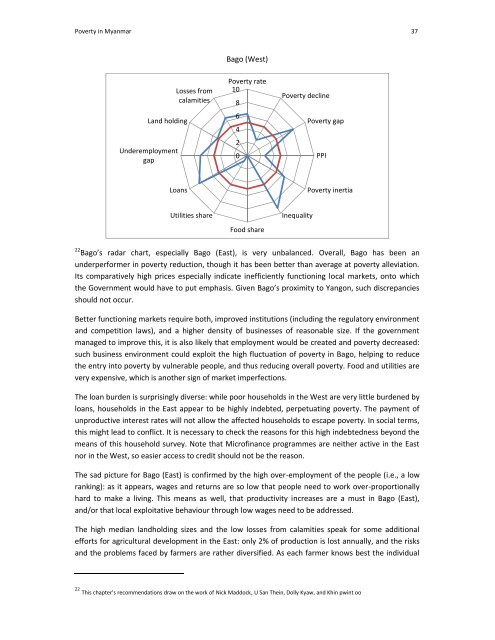A regional perspective on poverty in Myanmar - United Nations ...
A regional perspective on poverty in Myanmar - United Nations ...
A regional perspective on poverty in Myanmar - United Nations ...
You also want an ePaper? Increase the reach of your titles
YUMPU automatically turns print PDFs into web optimized ePapers that Google loves.
Poverty <strong>in</strong> <strong>Myanmar</strong> 37<br />
Bago (West)<br />
Land hold<strong>in</strong>g<br />
Underemployment<br />
gap<br />
Losses from<br />
calamities<br />
Poverty rate<br />
10<br />
8<br />
6<br />
4<br />
2<br />
0<br />
Poverty decl<strong>in</strong>e<br />
Poverty gap<br />
PPI<br />
Loans<br />
Poverty <strong>in</strong>ertia<br />
Utilities share<br />
Food share<br />
Inequality<br />
22 Bago’s radar chart, especially Bago (East), is very unbalanced. Overall, Bago has been an<br />
underperformer <strong>in</strong> <strong>poverty</strong> reducti<strong>on</strong>, though it has been better than average at <strong>poverty</strong> alleviati<strong>on</strong>.<br />
Its comparatively high prices especially <strong>in</strong>dicate <strong>in</strong>efficiently functi<strong>on</strong><strong>in</strong>g local markets, <strong>on</strong>to which<br />
the Government would have to put emphasis. Given Bago’s proximity to Yang<strong>on</strong>, such discrepancies<br />
should not occur.<br />
Better functi<strong>on</strong><strong>in</strong>g markets require both, improved <strong>in</strong>stituti<strong>on</strong>s (<strong>in</strong>clud<strong>in</strong>g the regulatory envir<strong>on</strong>ment<br />
and competiti<strong>on</strong> laws), and a higher density of bus<strong>in</strong>esses of reas<strong>on</strong>able size. If the government<br />
managed to improve this, it is also likely that employment would be created and <strong>poverty</strong> decreased:<br />
such bus<strong>in</strong>ess envir<strong>on</strong>ment could exploit the high fluctuati<strong>on</strong> of <strong>poverty</strong> <strong>in</strong> Bago, help<strong>in</strong>g to reduce<br />
the entry <strong>in</strong>to <strong>poverty</strong> by vulnerable people, and thus reduc<strong>in</strong>g overall <strong>poverty</strong>. Food and utilities are<br />
very expensive, which is another sign of market imperfecti<strong>on</strong>s.<br />
The loan burden is surpris<strong>in</strong>gly diverse: while poor households <strong>in</strong> the West are very little burdened by<br />
loans, households <strong>in</strong> the East appear to be highly <strong>in</strong>debted, perpetuat<strong>in</strong>g <strong>poverty</strong>. The payment of<br />
unproductive <strong>in</strong>terest rates will not allow the affected households to escape <strong>poverty</strong>. In social terms,<br />
this might lead to c<strong>on</strong>flict. It is necessary to check the reas<strong>on</strong>s for this high <strong>in</strong>debtedness bey<strong>on</strong>d the<br />
means of this household survey. Note that Microf<strong>in</strong>ance programmes are neither active <strong>in</strong> the East<br />
nor <strong>in</strong> the West, so easier access to credit should not be the reas<strong>on</strong>.<br />
The sad picture for Bago (East) is c<strong>on</strong>firmed by the high over-employment of the people (i.e., a low<br />
rank<strong>in</strong>g): as it appears, wages and returns are so low that people need to work over-proporti<strong>on</strong>ally<br />
hard to make a liv<strong>in</strong>g. This means as well, that productivity <strong>in</strong>creases are a must <strong>in</strong> Bago (East),<br />
and/or that local exploitative behaviour through low wages need to be addressed.<br />
The high median landhold<strong>in</strong>g sizes and the low losses from calamities speak for some additi<strong>on</strong>al<br />
efforts for agricultural development <strong>in</strong> the East: <strong>on</strong>ly 2% of producti<strong>on</strong> is lost annually, and the risks<br />
and the problems faced by farmers are rather diversified. As each farmer knows best the <strong>in</strong>dividual<br />
22 This chapter’s recommendati<strong>on</strong>s draw <strong>on</strong> the work of Nick Maddock, U San The<strong>in</strong>, Dolly Kyaw, and Kh<strong>in</strong> pw<strong>in</strong>t oo

















